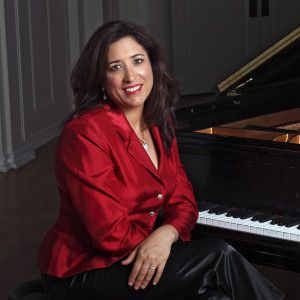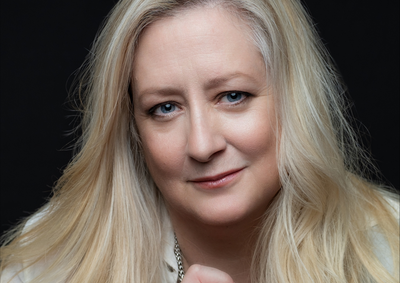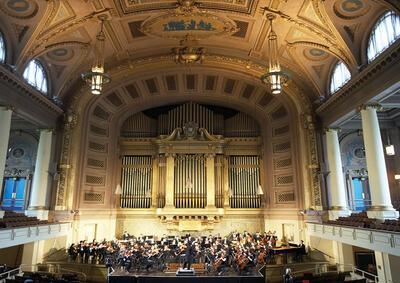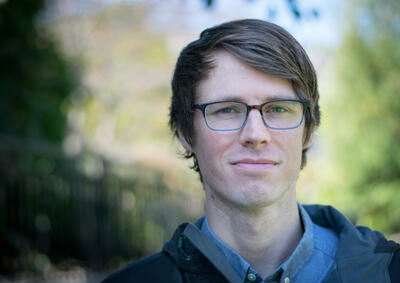Then and Now: A Conversation with Pianist Susan Merdinger
 Fanfare Magazine
Fanfare Magazine
By Jerry Dubins
Susan Merdinger received her formal education at Yale University, the Yale School of Music, the Manhattan School of Music, the Westchester Conservatory of Music, and the École Normale de Musique in Fontainebleau, France. Her teachers have included noted pianists Ward Davenny, Constance Keene, Claude Frank, Seymour Lipkin, Ozan Marsh, and Gaby Casadesus for piano, and she has had coaching and/or masterclasses with Peter Serkin, Philippe Entremont, Byron Janis, and Karl Ulrich Schnabel, among others. Susan is currently on the piano faculties of the Summit Music Festival in New York, the Burgos International Music Festival in Spain, and the Fine Arts Music Society Festival in Indiana, and she is the Artistic Director and Founder of Sheridan Music Studio of Highland Park, Illinois.
A list of Merdinger’s many honors, prizes, and awards would fill half a page, but to note just two of them, a “then” and “now,” in 1986 she was a Winner of the Artist International Young Musicians Competition, and in 2012 she won First Prize in Bradshaw and Buono International Piano Competition Professional Division. She is a laureate of the prestigious Leeds International Piano Competition, the Montréal International Concours de Musique, and the William Kappell International Piano Competition.
With a large repertoire spanning three centuries, Merdinger has toured Europe and the U.S. and has performed in major concerts halls such as Carnegie Recital Hall, Merkin Concert Hall, Preston Bradley Hall, and Diligentia Hall. She regularly performs as a soloist with orchestras, recitalist, duo pianist, and as a collaborative pianist with distinguished members of the New York Philharmonic, the New Jersey Symphony, and the Chicago Symphony Orchestra.
Susan’s current discography includes five CDs of solo piano, duo piano, and chamber music on the Sheridan Music Studio label, all available on iTunes, CDBaby, and Amazon.
Jerry: I titled our interview “Then and Now” because one of two CDs that came to me for review, Retrospection , documents your work as a student at Yale in 1983 and 1984. The other disc, a Schumann studio recording and recital, is comparatively recent, dating from 2011–12. A lot happens to a musician in terms of artistic growth over a period of that many years, so tell me, not just how your approach to playing the piano has evolved over time, but how your attitudes towards and understanding of music in general has changed.
Susan: You know how they say “a leopard doesn’t change its spots”? Well, to a certain extent that is very true for me. The essence of my character, personality, and approach to music hasn’t changed, but I’ve come under many different influences over the years, and that has only expanded my perspective and knowledge, while my substantial performing experience has increased my conviction and confidence.
The two main perspectives I bring to my music-making are intellectual/analytical and psychological/emotional, and the balance of these elements has changed during the course of my life. The first component naturally encompasses knowing as much about the composers and their lives, as well as the historical time period in which they were living, as well as a thorough knowledge of the theory, harmony, and performance practice of each genre of music I perform. I was saturated in this element during my years at Yale, and I must say I loved it.
The emotional/psychological part for me comes down to simply asking myself, what is the composer trying to communicate and how will I best convey this musically? I’ve always tried to mesh the intellectual component with the emotional one, but as a youth I think I leaned towards playing from my heart without as much analysis about the effect. At Yale, I took courses in psychology, and specifically the psychology of music, and have continued my informal private study of psychology as it pertains to teaching and performance. As a result, I now tend to think about the potential emotional effect the music has, and how I want to bring it out. Thus, the psychological component is now fully integrated with the intellectual component of my playing, making everything simply more intuitive, more natural.
I also feel that I’m a more perceptive listener now, as a result of interacting with so many more musicians over the years. I’ve learned as much or more being out of school than I did when I was in school. The formal education was absolutely essential and stimulating, but the learning doesn’t stop when you leave; it just increases, intensifies, evolves.
I think the biggest change in me over these past 25 years is that I matured from being a student to being an independent artist. I was still very much under the influence of my teachers in 1983–84, as well as the many academic professors I had at the time. However, I believe that every artist must develop his or her own personal voice, and over the past 30 years or so, I’ve tried to do exactly that. I’m grateful for what my teachers taught me, though, because I have an approach which is more balanced between the intellectual and emotional aspects.
Jerry: You’ve had many different teachers during your formative years. What type of advice were you given by your teachers and mentors during that time?
Susan: Constance Keene told me, “Always leave your audience wanting more,” and she always emphasized the importance of shaping the melodic line, projection, and stage presence. Claude Frank, on the other hand, emphasized the color of the harmonies, and the voicing, which have a huge impact on the tone and sound of a pianist. My early teacher Michael Pollon, who I occasionally played for even during college, was very strict and demanding. His advice to me when learning a Chopin étude was, “Never forgive a single note,” or when playing a Mozart concerto, “Make every single note sound like a perfect, lustrous pearl.”
Ward Davenny was very much concerned with tone production, and was probably the one teacher who taught me most about overall structural coherence and tempo relationships for larger-scale works; and he was a stickler for fingering passages properly. A most oft-repeated admonition to me about interpretation was, “Play Chopin like Mozart, and Mozart like Chopin.” Davenny also liked to tell me to play like “ice on fire” or “fire on ice,” depending on the circumstances of the music and my mood. And so I did. And I still do, because is there anything more romantic than a slow movement of a Mozart piano concerto? It all comes down to finding exactly the right balance and having honesty and sincerity in one’s playing.
Jerry: What do you think are the specific ingredients for success in being a professional musician and performing artist?
Susan: I once played for a very prominent pianist who told me that I had a “strong temperament,” which he claimed was a very good thing, since he said it’s easier to reign in a young pianist’s emotions than to try to teach musical expressivity to him or her. I’ve read a lot of scientific studies about emotion in music, and my experience of teaching and analyzing what makes a performance expressive and communicative has led me to believe that while it’s certainly possible to teach such expression, doing so is definitely much harder than just simply teaching musical conventions and the mechanics of playing the piano.
So, I do feel that the ability to make music come alive is what some people call a “gift,” and for many musicians it’s present from the minute they start singing or playing an instrument, lessons and teachers notwithstanding. Having recently read Melvin Overton’s book Talent is Overrated I would have to agree with his premise in some respects, but I personally feel that there is no substitute for talent, period. In order to be successful in this performing career, one must have both talent and discipline. Certainly, talent without hard work gets you nowhere, but hard work without a certain amount of natural talent is also futile, if you strive to be a professional musician.
In addition to talent and discipline, perhaps the most critical components of success in music are passion and desire. People often ask me if my Mom was strict with me when I was little, and whether she made me practice. They’re often surprised when I tell them that it was exactly the opposite; she used to implore me to stop practicing in order to do my homework, clean up my room, or simply go out to play and have some fun. Never once did she tell me to practice or have to remind me to do so. My Mom likes to tell everyone the story about how kids in the neighborhood would come over to see if my sister and I wanted to play, and I would tell them, “I need to finish practicing my piece first.” Needless to say, I never, ever “finished.”
After 30-plus years of being a concert pianist, I’ve lived a life which exposed me to a wealth of emotions, social interactions, and pivotal experiences which I believe have made me a more complete person, both emotionally and intellectually. I married a pianist who I met at the Yale School of Music, Steven Greene (who chose to pursue a full-time career in finance, while still maintaining a part-time career in music as an organist and accompanist), and we have had three children together, all of whom are poised to become high-level professional musicians. Steve has been absolutely instrumental in my becoming the musician I am today. He’s been my extra pair of ears, my sounding board, so to speak, for 27 years now.
I’ve also experienced death of many loved ones, both family and teachers. The grief I felt when my father died was deep and unrelenting for over a year, but it was my music that kept me going. I went on and performed just a month after his funeral in a concert series that I’d just formed in the fall of 2007, Sheridan Solisti. It was something he would have wanted me to do, and it marked a new beginning for me.
Jerry: So, tell me about the “Then”—your student recital disc of works by Bach, Chopin, Debussy, and Mendelssohn.
Susan: For starters, one reason these recordings sat in a closet was that I never thought they were good enough. Yet, some of them are the very recordings that helped me gain entrance into prestigious international competitions, so I have no idea why I thought they had no merit.
The repertoire on this CD consists mostly of shorter works, but ones which I really love. It took 25-plus years to see the value in them, and in “retrospect” (pun intended), I concluded that my early work was important to document and was just as valid as what I’m capable of producing now. What started out as a simple discovery process became a revelation. It almost felt like I was listening to a different pianist, and it was like opening up a time capsule. That’s why I called the album “Retrospection.” I also felt that I couldn’t move forward with making new recordings until I preserved my old ones. I worked so diligently with the remastering sound engineers to get the sound as true to the original recordings engineered by Yale School of Music Recording Engineer, Eugene Kimball.
I’m certainly no expert on the technology, but it’s always difficult to convey to an engineer what you are looking for in terms of sound. I also worried about adding any artifact that was not in the original recordings, such as reverb. I just didn’t want it to sound artificial or to affect the clarity of the music.
I’ve been an avid buyer of LPs and now CDs over the years, but I primarily live in the realm of live performances, whether I go to them or perform in them. This is why I have included some “live” performance on this recording as well. What I’ve discovered is that there are so many imperfections in the acoustical properties of concert halls and pianos, and variances in one’s impressions depending on where one sits, that only now am I beginning to recognize the value of the controlled environment that a studio recording can represent. So, finally now and going forward, I’m particularly gratified to join the ranks of artists who issue professional, commercially-available CDs.
Jerry: I noticed in your bio that you’ve also studied conducting. Have any opportunities come your way to perform in that capacity? Do you find when performing as a pianist with orchestra that your knowledge of conducting gives you a different insight into the score than you otherwise might not have? Does it give you a better understanding of the instruments of the orchestra and the particular technical challenges faced by the players?
Susan: For many years, I earned my keep as a church musician. My most recent stint was as the music director for the Unitarian Society of Ridgewood, New Jersey, a post I really enjoyed and cherished, until we relocated to Chicago due to my husband’s job change after the catastrophe of 9/11. In that position, and also as an organist and music director at a Lutheran Church and at a Reform Synagogue, I also served in the capacity as a choral director. Thus, I’ve had a good deal of experience as a choral conductor, but not much professional experience as an orchestral conductor.
I would say that my greatest insights to playing with an orchestra come not only from my conducting studies, but also to my serious studies of flute, which I played all the way through my undergraduate degree at Yale as a secondary instrument, but I pretty much knew from the age of seven that I wanted to be a concert pianist, so the flute was my “hobby.”
Performing as a flutist, singer, and pianist in a variety of ensembles enabled me to perform a more varied repertoire, and to learn about conducting from actually observing and following conductors from an early age. This was quite a vital experience for me, and all of these studies allow me to understand what the musicians of the orchestra face, because I’ve been in their shoes, too.
I also learned a lot about articulation and attacks and release of notes, breathing and phrasing, not to mention the importance of quality of tone. I love the sound of an orchestra, especially in combination with the piano, which is why I enjoy performing concertos and playing chamber music as much as performing solo piano repertoire.
Jerry: Getting around to the “Now” part of this interview, your most recent recording, reviewed below, is an all-Schumann album, which has already received one glowing review in Fanfare. I understand there’s quite a bit of history behind that CD and that it’s very near and dear to you. Tell me about it.
Susan: This recording was 25 years plus in the making, in my heart and in my brain. The Carnaval was part of my Master of Music Degree Recital at Yale, and I worked on it primarily with Ward Davenny, although I played it for several others in the years following, most notably, Constance Keene. It was the piece that helped me win the Artists International Young Musicians Competition in New York, in 1986, and it’s a piece I toured with to great acclaim in Europe, performed at the Yale-Norfolk Music Festival, and eventually performed on my New York solo recital debut in 1987 at Carnegie-Weill Recital Hall. Also, as a relative newcomer to Chicago, I chose to perform Carnaval on my live debut performance broadcast on Chicago’s classical radio station WFMT. I truly consider it my “signature” piece.
I always identified not just with Robert Schumann’s very programmatic and personal music but also with his wife, Clara Wieck Schumann, who was his staunchest supporter and proponent of her husband’s music. I was so enraptured with their romantic story of meeting in their youth, Robert being nine years older than Clara, and being so smitten with her prodigious piano playing that he wanted to study with her father. And then there was the heartache of Clara and Robert’s surreptitious romance, when her father objected to Clara’s marriage to Robert and tried to prevent it through legal court actions. Clara and Robert finally did marry in 1840, well after Robert’s composition of Carnaval in 1834–1835. Not to mention that the role model of Clara Schumann, one of the most distinguished concert pianists and composers of her time, and a mother of seven children, no less, is quite appealing to me.
Carnaval is really a musical autobiography of Schumann’s life until that point—a highly programmatic depiction of the people, places, and themes Schumann experienced: the Italian commedia dell’arte characters, combined with vignettes representing Schumann himself (Eusebius and Florestan, his two alter-egos); his former beau, Ernestine von Fricken (Estrella—notice how this piece ends abruptly—as did his relationship with her when he found out she was the illegitimate daughter of a nobleman!); his colleagues Chopin and Paganini (perhaps the technically trickiest portion of the entire work, as one might expect of something depicting the ground-breaking violin virtuoso’s famously difficult works); Clara (Chiarina); a German town in which Ernestine von Fricken came from (“ASCH—Lettres Dansantes”); individual pieces featuring two clearly delineated voices, possibly representing himself and Clara (“Reconnaissance”); and simple solo avowals of his love for Clara (“Aveu”). In my opinion, the creative genius and spark of this piece is evident from start to finish, and my own imagination of a detailed story behind each “scene” is what helps me bring it to life.
Jerry: Why did you choose to pair Carnaval with Faschingsschwank aus Wien on this CD?
Susan: I simply wondered why these two pieces were not more often paired together on one disc, when they are so obviously related to each other and complement each other so well. Aside from the “carnival” theme common to both works, one feature we see in both Carnaval and Faschingsschwank is the interplay of two voices in the treble and the bass at various points in each piece, particularly in the Finale of Faschingsschwank , or the middle section of “Reconnaissance.” In the opening Allegro movement of op. 26, we see a “mini” version of Carnaval , in a sense, a sonata-rondo form which features many different “vignettes” alternating with the main chordal ritornello, and the musical joke of La Marseillaise (then banned from public performance in Germany) interrupting in the middle of the movement. A brilliantly conceived reprise of the opening “Preambule” material also occurs in the Finale of Carnaval , tying everything together. The main difference between the two works, of course, lies in the overall structures, with the miniature binary forms of the pieces in Carnaval contrasting with the more formal sonata structure of Faschingsschwank . I felt that placing both of these pieces on my first all-Schumann CD would be a very interesting juxtaposition of both styles/forms of Schumann’s compositions.
Jerry: So, with an active and burgeoning career, what was the reason for the long time-span between your professional recordings?
Susan: As a result of wanting to do something to gain attention and propel my career, at a certain point in the late 1990s, while I was living in Montvale, New Jersey, and already had my three young children, I decided to embark on recording Carnaval and other works. I rented the main hall at SUNY, Purchase, and hired a young, highly-recommended recording engineer, and spent a full day recording Carnaval for starters. But there were problems, and I simply could not work with the piano, which had major issues with the dampers being sticky and messing up my pedaling something dreadful.
The engineer kept stopping me every eight measures, telling me to do it again and again, and he didn’t believe me when I kept insisting that there was something wrong with the piano that needed to be fixed. After eight hours of my wasted time and money, I cancelled the remaining two days of recording, because I couldn’t rationalize throwing more good money after bad, which greatly upset the engineer. But I paid him in full for that full day, and never asked for, expected, nor received the recorded material. Thus, my dream of making a brand new Schumann CD in the late 1990s was crushed, and due to numerous financial and personal circumstances beyond my control, it never came to fruition until I moved to Chicago.
So ever since the 1990s, I’ve relied on using my live concert recordings for any publicity I needed; I’ve always preferred giving live concerts. This digitally recorded Schumann CD represents my first studio recording since 1988, when I recorded several works (on analog tape) at the Clinton Recording Studio in New York, on a beautiful Baldwin SD-10 piano that was brought in for the session, since I was a Baldwin Artist from 1988 until 2012.
The Schumann Carnaval CD was recorded on two different Steinway Ds, in two different venues. I recorded Carnaval at WFMT in April 2011, during which time I was in midst of performing a full recital program of different repertoire, so six months later, I decided to record Faschingsschwank so I could create a complete CD of all-Schumann. I changed venues primarily because I wanted to hire a videographer to record the session as a “live” performance, so I needed a nice backdrop, which the Nichols Hall in Evanston provided. The Faschingsschwank recording session can also be viewed on my YouTube channel.
Overall, I feel I got the results I wanted with both pianos and venues, and am proud to be recording again on Steinway pianos, having become an International Steinway Artist last December, 2012. This honor brought me full circle, since I was 13 years old when my mother, Joan Merdinger, insisted to my father that I needed to have a Steinway Piano in order to become a concert pianist, and they made a big investment in me which I would say has definitely paid off!
Once the master of both pieces was made into the CD, I still could barely bring myself to listen to the finished product. I was almost afraid to do so. After all, a musician’s fondest hope is to bring pleasure and beauty into people’s lives and touch their hearts in a way that only music can. Would this CD accomplish that lofty goal, I wondered? I had lived with and performed this music for so long, and I finally felt so strongly compelled to get it all laid down and recorded for posterity. Perhaps I came to the conclusion that all my work over these years performing concerts would disappear into thin air and be for naught if I didn’t make recordings and make some mark in the music world or, at the very least, leave a legacy for my three children.





